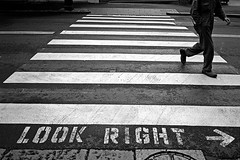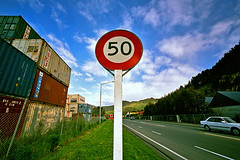|
Voigtlander was started in 1756 by Johann Christoph Voigtlander, the company was sold to Zeiss in 1956, then to Rollei in 1973, then to Plusfoto in 1982 and then to Ringfoto in 1997. In 1999 Cosina started producing rangefinder cameras and lenses under the Voigtlander name and in 2004 my love affair with the Voigtlander rangefinder began!
|
 My two Voigtlander rangefinders, the R3A on the left and the L on the right, supported by the new couch. And yes, it is as comfortable as it looks! |
|||
| My first exposure to Voigtlander rangefinders was at work. We had a silver Voigtlander Bessa L & 15mm on the second hand shelf and I had never taken any notice of it until I saw the results that another member of staff got when they borrowed it, it was so wide! I immediately plucked the camera off the shelf, wrote it up in the loaner book, put a roll of film in it and I was off. I took photos on the way home and around my neighborhood, when I took the film into work the next day I was a little disappointed, my left index finder was appearing at the bottom of most of the photos, I was still holding the lens like the Xpan and because it was so wide, it was in the photos. Despite this one setback some of the other photos without my finger were great and I was hooked. | ||||
|
In late 2004 I accidentally won a Voigtlander Bessa R on TradeMe (New Zealand's version of eBay, the reserve was lowered below my highest bid) and so of course I needed a lens, there was a second hand Voigtlander 35mm Color Skopar Classic on B&H rather cheap so I jumped at it, wasn't I surprised when I opened the box and found out it was actually a Pancake version! I took both cameras and the Xpan to Australia in 2005 but I sold Bessa R & 35mm just before I went to Japan in 2006, because I wasn't using it and also because I wanted to buy a black Panasonic LX1 in Japan. In mid 2006 a mate borrowed the Bessa L & 15mm and loved it, so much so he wanted to buy it, lucky for him I had been thinking about buying the Voigtlander 12mm Ultra Wide Heliar so I bought a 12mm and Bessa L body off eBay and the deal was done. In early 2007 I bought a Voigtlander Bessa R3A & Nokton 40mm off eBay and picked it up when I visited Melbourne for the first time. |
|
|||
|
||||
|
That was a mouthful! So here we are today, what do I have left? I have the Bessa L & 12/5.6 and Bessa R3A & 40/1.4. The 12mm is really, really, really wide, so wide it is unbelievable but the vignetting is quite bad, even when compared to the 15mm. I'm not too phased by it. The optical resolution is also not so good, especially when (I know I shouldn't do it) compared to Hasselblad's 30mm Xpan lens. The 40mm is a magical lens, mostly, I suppose, because of the effect the large aperture creates and it's sharpness. I use the term magical because I know that on a couple of occasions I have not focused correctly, or at all and the pictures have come out looking fine and also it seems to have a “glow” to it, shots are sharp but smooth at the same time. |
|||
|
The cameras are, well, just cameras, the Bessa L is great for the 12mm because the metering display on the outside and the Bessa R3A is a beautiful camera, everyone who picks it up is very impressed by its solidity, it also has 40mm framelines built in. I have not had any trouble like others have had with the two cameras, although my old Bessa R did jam up on me on one occasion and one day I thought the R3A had carked it, but all it needed was some new batteries.
|
||||
|
People often ask me if the R3A is a Leica and I say, “It's a practical (or poor) man's Leica”. There are new versions now available with wider framelines (R4A) and mechanical versions that do not require batteries (R3M & R4M). Don't be misled by some of the sites selling them online, you would be led to believe that they are the only people who sell them when actually most of the big online camera stores stock them. I encourage anyone who is thinking about getting a Voigtlander rangefinder to get one, you will not be disappointed. If you would like to see some of my shots taken on Voigtlander rangefinders, please click on the following link: Voigtlander Gallery. Cheers! Matthew Joseph aka Fotodudenz |
||||

 The shutter speed dial on the R3A. It is a manual
camera with aperture priority and also has exposure compensation.
You also set the film's ISO here.
The shutter speed dial on the R3A. It is a manual
camera with aperture priority and also has exposure compensation.
You also set the film's ISO here.






